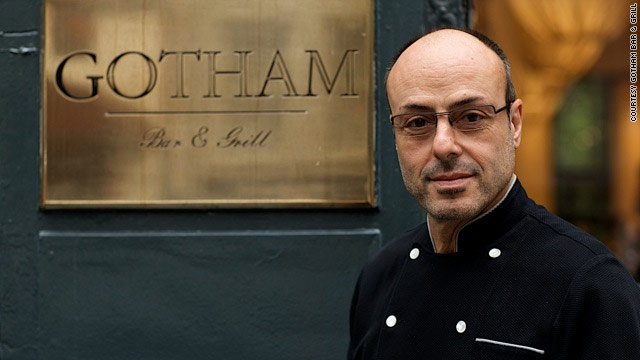5@5 is a daily, food-related list from chefs, writers, political pundits, musicians, actors, and all manner of opinionated people from around the globe.
If you think
you'll go for a walk outside now, and the spring sun is in fact, calling your name - pick up some asparagus at the farmers market while you're at it
.For the last 25 years, Alfred Portale has been at the helm of the storied New York City restaurant
Gotham Bar & Grill utilizing local purveyors for seasonal, of-the-moment dishes. Under his watch, the restaurant has won a
James Beard Foundation Award for "Outstanding Restaurant" and
earned one Michelin star. Chef Portale was also recognized as the James Beard Foundation's "Outstanding Chef" in 2006.
Five Reasons to Shop Local - Now: Alfred Portale1. Variety"Walking through the
Union Square Greenmarket is a great inspiration for me. The variety of produce and even the colors help me develop our seasonal menu changes.
Greenmarket farmers grow over 100 types each of apples and tomatoes. Biodiversity not only produces a host of flavors and colors it also helps protect our food supply as greater genetic diversity means less vulnerability to disease and pests."
2. Safety
"We are finding more and more of our customers are asking where our products are coming from and how they are grown. Knowing the actual farmers and how they grow their products makes me that much more proud of what we offer at Gotham.
Buy your food from the person who grew it - knowing where your food was grown ensures accountability and traceability."
3. Taste
"Maybe the most important for us is the fact that fresher/better ingredients make better dishes. The Greenmarket produce is as fresh as it gets, we actually couldn’t do what we do without these great ingredients. Greenmarket produce is picked when it’s ready to eat – not left to ripen on a supermarket shelf. Plus, fresher food is better for you as it contains more nutrients."
4. Community
"We make every effort to work with our local farms year round and many of these farms feel to us more like friends than purveyors. I think it makes all the food taste better when you know the person who grew it.
People from all backgrounds come together around food. Fresh air, locally grown foods, trying something new, the chance to meet your friends and neighbors -
shopping at farmers markets is a great experience."
5. Preservation
"By giving farmers an outlet to sell their produce, Greenmarket helps keep agricultural land in production. Over 30,000 acres of land are dedicated to small-scale food production and open space thanks to Greenmarket farmers."









































